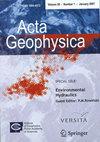Seismic hazard assessment of Agartala agglomeration based on 1D nonlinear ground response analysis and empirically derived liquefaction susceptibility
Abstract
Local site conditions recognized as a determining factor in assessing the extent of seismic hazard and damage distribution during earthquakes. Present study emphasizes seismic hazard of international business corridor of Agartala town capital of Tripura, one of the northeastern state of India categorized as highest seismic zone (zone V) attributing seismic response of local subsoil deposits under site-specific scenario earthquake motions including liquefaction susceptibility prediction. One-dimensional nonlinear ground response analysis with input of geotechnical parameters was carried using DEEPSOIL (2018) program across central zone of Agartala city and liquefaction susceptibility analysis are performed based on standard penetration test (SPT) utilizing well-established empirical relationship. The novelty of results lies in use of site-specific dynamic parameters of subsoil and synthetic ground motions based on scenario earthquake. Besides, numerical model was validated with a recent past liquefaction case study in Tripura which also attributes key highlight of this study. Key seismic hazard parameters in the form of peak ground acceleration (PGA), amplification factor (Af), and predominant frequencies (fn) are presented through geographical information based spatial maps. These maps provide crucial inputs for planners and designers for future urban planning along with seismic strengthening of existing infrastructures. This comprehensive approach offers new perspectives on seismic hazard assessment and future management plan in this region.

 求助内容:
求助内容: 应助结果提醒方式:
应助结果提醒方式:


